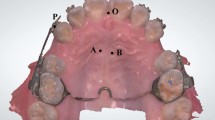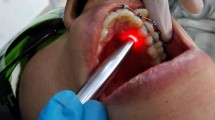Abstract
The aim of this study was to evaluate the effects of low-level laser irradiation on the rate of orthodontic tooth movement (OTM) and the interleukin-6 (IL-6) concentration in gingival crevicular fluid (GCF) during orthodontic treatment. In this randomized split-mouth double blind clinical trial, 11 female patients aged 14 to 25 years (mean 19 ± 4.21 year), who required canine retraction following four first premolars extraction, were selected. The GaAlAs laser diode laser (A.R.C. Laser GmbH, Nürnberg, Germany) (980 nm, 100 mW, 5.6 J/cm2, three points from the buccal side and three from lingual side of the tooth, 56 s, running in continuous mode) was used for canine retraction in only one maxillary quadrant (LG). The irradiation time for each cervical and middle third of the tooth was 10 s, and 8 s for the apical third of the tooth. The other maxillary quadrant served as the control group (CG) using the laser pseudo-application in this side. The laser irradiation was applied on days 0, 7, 14, 21, and 28 of each month during the canine retraction phase. Canine retraction was done using closed coil spring with 150 g force on rectangular wires after the alignment and leveling. This study was done in 11 months. Dental casts were made at different time points during the treatment, and the amount of tooth movement was measured. To evaluate the levels of IL-6, GCF samples were collected from the distal side of the maxillary canine teeth on both quadrants at the beginning of the trial, the end of aligning phase, and on day 21 of each month during canine retraction. Although the mean rate of canine retraction was higher in the LG (0.013) than the CG (0.012) and there was definitely a tendency for more canine retraction in the LLLI, but the results failed to show any significant difference between the mean rate of canine retraction of both groups (P = 0.068). A paired t test showed that there was no significant difference in the mean concentration of IL-6 at various stages of the treatment between the groups during canine distalization (P > 0.05). Therefore, conclusive evidence could not be provided to support the efficacy of the diode laser (980 nm) in accelerating OTM in female subject.



Similar content being viewed by others
References
Limpanichkul W, Godfrey K, Srisuk N, Rattanayatikul C (2006) Effects of low‐level laser therapy on the rate of orthodontic tooth movement. Orthod Craniofac Res 9:38–43
Shirazi M, Akhoundi MSA, Javadi E, Kamali A, Motahhari P, Rashidpour M, Chiniforush N (2015) The effects of diode laser (660 nm) on the rate of tooth movements: an animal study. Lasers Med Sci 30:713–718. doi:10.1007/s10103-013-1407-1
Hashimoto F, Kobayashi Y, Mataki S, Kobayashi K, Kato Y, Sakai H (2001) Administration of osteocalcin accelerates orthodontic tooth movement induced by a closed coil spring in rats. Eur J Orthod 23:535–546
Akın E, Gurton AU, Ölmez H (2004) Effects of nitric oxide in orthodontic tooth movement in rats. Am J Orthod Dentofac Orthop 126:608–614
Bartzela T, Türp JC, Motschall E, Maltha JC (2009) Medication effects on the rate of orthodontic tooth movement: a systematic literature review. Am J Orthod Dentofac Orthop 135:16–26. doi:10.1016/j.ajodo.2008.08.016
Seifi M, Eslami B, Saffar AS (2003) The effect of prostaglandin E2 and calcium gluconate on orthodontic tooth movement and root resorption in rats. Eur J Orthod 25:199–204
Cruz DR, Kohara EK, Ribeiro MS, Wetter NU (2004) Effects of low-intensity laser therapy on the orthodontic movement velocity of human teeth: a preliminary study. Lasers Surg Med 35:117–120
Tortamano A, Lenzi DC, Haddad ACSS, Bottino MC, Dominguez GC, Vigorito JW (2009) Low-level laser therapy for pain caused by placement of the first orthodontic archwire: a randomized clinical trial. Am J Orthod Dentofac Orthop 136:662–667. doi:10.1016/j.ajodo.2008.06.028
Youssef M, Ashkar S, Hamade E, Gutknecht N, Lampert F, Mir M (2008) The effect of low-level laser therapy during orthodontic movement: a preliminary study. Lasers Med Sci 23:27–33
Eslamian L, Borzabadi-Farahani A, Hassanzadeh-Azhiri A, Badiee MR, Fekrazad R (2014) The effect of 810-nm low-level laser therapy on pain caused by orthodontic elastomeric separators. Lasers Med Sci 29:559–564. doi:10.1007/s10103-012-1258-1
Shi Q, Yang S, Jia F, Xu J (2015) Does low level laser therapy relieve the pain caused by the placement of the orthodontic separators?—a meta-analysis. Head Face Med 28:11–28. doi:10.1186/s13005-015-0085-6
Marini I, Bartolucci ML, Bortolotti F, Innocenti G, Gatto MR, Bonetti GA (2015) The effect of diode superpulsed low-level laser therapy on experimental orthodontic pain caused by elastomeric separators: a randomized controlled clinical trial. Lasers Med Sci 30:35–41. doi:10.1007/s10103-013-1345-y
Domínguez A, Velásquez SA (2013) Effect of low-level laser therapy on pain following activation of orthodontic final archwires: a randomized controlled clinical trial. Photomed Laser Surg 31:36–40. doi:10.1089/pho.2012.3360
Altan BA, Sokucu O, Ozkut MM, Inan S (2012) Metrical and histological investigation of the effects of low-level laser therapy on orthodontic tooth movement. Lasers Med Sci 27:131–140. doi:10.1007/s10103-010-0853-2
Genc G, Kocadereli İ, Tasar F, Kilinc K, El S, Sarkarati B (2013) Effect of low-level laser therapy (LLLT) on orthodontic tooth movement. Lasers Med Sci 28:41–47. doi:10.1007/s10103-012-1059-6
Marquezan M, Bolognese AM, de Souza Araújo MT (2010) Effects of two low-intensity laser therapy protocols on experimental tooth movement. Photomed 28:757–762. doi:10.1089/pho.2009.2694
Kalemaj Z, DebernardI CL, Buti J (2015) Efficacy of surgical and non-surgical interventions on accelerating orthodontic tooth movement: a systematic review. Eur J Oral Implantol 8:9–24
Seifi M, Shafeei HA, Daneshdoost S, Mir M (2007) Effects of two types of low-level laser wave lengths (850 and 630 nm) on the orthodontic tooth movements in rabbits. Lasers Med Sci 22:261–264
Davidovitch Z (1991) Tooth movement. Crit Rev Oral Biol Med 2:411–450
Başaran G, Özer T, Kaya FA, Hamamci O (2006) Interleukins 2, 6, and 8 levels in human gingival sulcus during orthodontic treatment. Am J Orthod Dentofac Orthop 130:7, e1-6
Uematsu S, Mogi M, Deguchi T (1996) Interleukin (IL)-1β, IL-6, tumor necrosis factor-α, epidermal growth factor, and β2-microglobulin levels are elevated in gingival crevicular fluid during human orthodontic tooth movement. J Dent Res 75:562–567
Ren Y, Hazemeijer H, de Haan B, Qu N, de Vos P (2007) Cytokine profiles in crevicular fluid during orthodontic tooth movement of short and long durations. J Periodontal 78:453–458
Van Gastel J, Teughels W, Quirynen M, Struyf S, Van Damme J, Coucke W, Carels C (2011) Longitudinal changes in gingival crevicular fluid after placement of fixed orthodontic appliances. Am J Orthod Dentofac Orthop 139:735–744. doi:10.1016/j.ajodo.2009.10.043
Kansal A, Kittur N, Kumbhojkar V, Keluskar KM, Dahiya P (2014) Effects of low-intensity laser therapy on the rate of orthodontic tooth movement: a clinical trial. Den Res J 11:481–8
Hosseini MH, Mahmoodzadeh Darbandi M, Kamali A (2011) Effect of low level therapy on orthodontic movement in human. J Dent Med 24:156–164
Saito S, Shimizu N, Dentistry, F. N. U. S. (1997) Stimulatory effects of low-power laser irradiation on bone regeneration in midpalatal suture during expansion in the rat. Am J Orthod Dentofac Orthop 111:525–532
Luger EJ, Rochkind S, Wollman Y, Kogan G, Dekel S (1998) Effect of low‐power laser irradiation on the mechanical properties of bone fracture healing in rats. Lasers Surg Med 22:97–102
Sousa MVS, Pinzan A, Consolaro A, Henriques JFC, de Freitas MR (2014) Systematic literature review: influence of low-level laser on orthodontic movement and pain control in humans. Photomed Laser Surg 2:592–599. doi:10.1089/pho.2014.3789
Yoshida T, Yamaguchi M, Utsunomiya T, Kato M, Arai Y, Kaneda T, Kasai K (2009) Low‐energy laser irradiation accelerates the velocity of tooth movement via stimulation of the alveolar bone remodeling. Orthod Craniofac Res 12:289–298. doi:10.1111/j.1601-6343.2009.01464.x
Takeda Y (1988) Irradiation effect of low-energy laser on alveolar bone after tooth extraction. Experimental study in rats. Int J Oral Maxillofac Surg 17:388–391
Lagan KM, Clements BA, McDonough S, Baxter GD (2001) Low intensity laser therapy (830 nm) in the management of minor postsurgical wounds: a controlled clinical study. Lasers Surg Med 28:27–32
Alhashimi N, Frithiof L, Brudvik P, Bakhiet M (2001) Orthodontic tooth movement and de novo synthesis of proinflammatory cytokines. Am J Orthod Dentofac Orthop 119:307–312
Barbieri G, Solano P, Alarcón JA, Vernal R, Rios-Lugo J, Sanz M, Martín C (2012) Biochemical markers of bone metabolism in gingival crevicular fluid during early orthodontic tooth movement. Angle Orthod 83:63–69. doi:10.2319/022812-168.1
Perinetti G, Paolantonio M, D’Attilio M, D’Archivio D, Tripodi D, Femminella B, Spoto G (2002) Alkaline phosphatase activity in gingival crevicular fluid during human orthodontic tooth movement. Am J Orthod Dentofac Orthop 122:548–555
Lee KJ, Park YC, Yu HS, Choi SH, Yoo YJ (2004) Effects of continuous and interrupted orthodontic force on interleukin-1β and prostaglandin E 2 production in gingival crevicular fluid. Am J Orthod Dentofac Orthop 125:168–177
Dudic A, Kiliaridis S, Mombelli A, Giannopoulou C (2006) Composition changes in gingival crevicular fluid during orthodontic tooth movement: comparisons between tension and compression sides. Eur J Oral Sci 114:416–422
Tuncer BB, Özmeriç N, Tuncer C, Teoman İ, Çakilci B, Yücel A, Balos K (2005) Levels of interleukin-8 during tooth movement. Angle Orthod 75:631–636
Hirano T, Akira S, Taga T, Kishimoto T (1990) Biological and clinical aspects of interleukin 6. Immunol Today 11:443–449
Hirano T, Kishimoto T (1990) Interleukin-6. In: Sporn MB, Roberts AB (eds) Handbook of experimental pharmacology, peptide growth factors and their receptors. Springer- Verlag, Berlin, pp 633–665
Liu XH, Kirschenbaum A, Yao S, Levine AC (2005) The role of the interleukin-6/gp130 signaling pathway in bone metabolism. Vitam Horm 74:341–355
Junior JC, Kantarci A, Haffajee A, Teles RP, Fidel R, Figueredo CM (2011) Matrix metalloproteinases and chemokines in the gingival crevicular fluid during orthodontic tooth movement. Eur J Orthod 33:705–711. doi:10.1093/ejo/cjq148
Davidovitch Z, Nicolay OF, Ngan PW, Shanfeld JL (1988) Neurotransmitters, cytokines, and the control of alveolar bone remodeling in orthodontics. Dent Clin N Am 32:411–435
Acknowledgments
The authors gratefully acknowledge that this report is based on a thesis submitted to the School of Dentistry, Shahid Sadoughi University of Medical Sciences, in partial fulfillment of the requirement for a MS degree (grant No 3172). This study was financially supported and approved by the Shahid Sadoughi University of Medical Sciences, Yazd, Iran.
Author information
Authors and Affiliations
Corresponding author
Ethics declarations
Conflict of interest
The authors declare that they have no conflicts of interest.
Ethical standards
This clinical trial was verified by the ethical committee and the research vice chancellor of Shahid Sadoughi University of Medical Science by the P/17/1/31871 ethical code. All the patients or their parents signed informed consent.
Rights and permissions
About this article
Cite this article
Yassaei, S., Aghili, H., Afshari, J.T. et al. Effects of diode laser (980 nm) on orthodontic tooth movement and interleukin 6 levels in gingival crevicular fluid in female subjects. Lasers Med Sci 31, 1751–1759 (2016). https://doi.org/10.1007/s10103-016-2045-1
Received:
Accepted:
Published:
Issue Date:
DOI: https://doi.org/10.1007/s10103-016-2045-1




